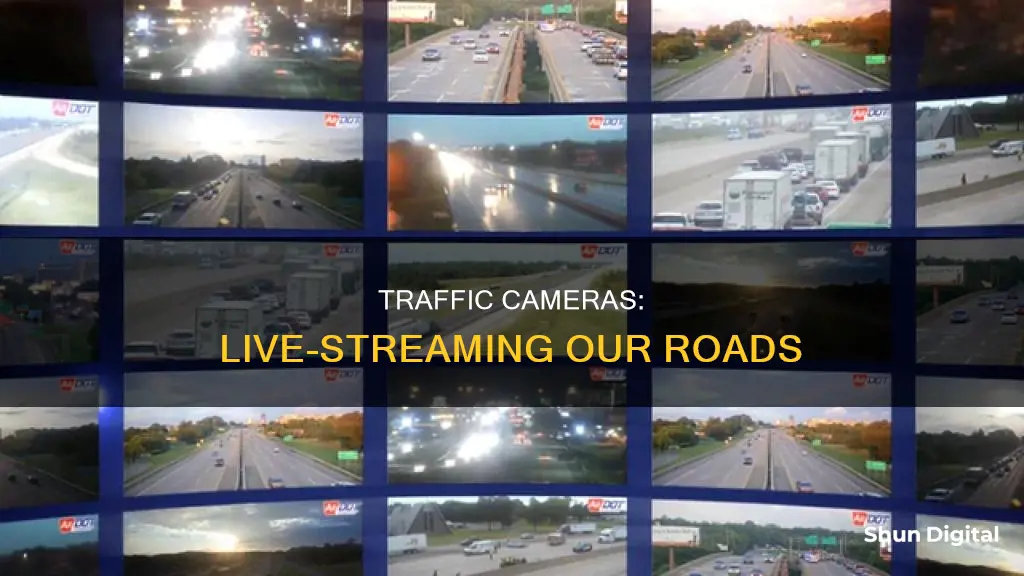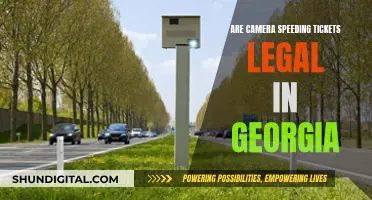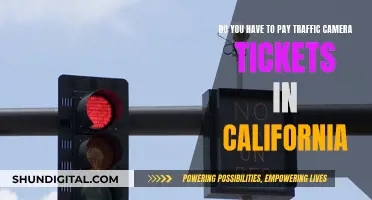
Live traffic cameras are cameras that are installed in various locations, including large cities and small towns, to monitor and provide live footage of traffic conditions. They are used to help people prepare for their trips and avoid congestion by offering a real-time view of the traffic situation. These cameras are often accessible through websites or applications, providing users with a command centre-like experience. Live traffic cameras are particularly useful for checking road conditions before embarking on a journey, and some organisations, such as the Maryland Department of Transportation, offer this service.
| Characteristics | Values |
|---|---|
| Purpose | Viewing current traffic conditions |
| Data storage | No images or videos are stored |
| Camera Network | TrafficLand has over 18,000 cameras in 200+ cities |
| Camera Locations | Large cities and small towns |
What You'll Learn
- Live traffic cameras help monitor and report on current road conditions
- They are used by media outlets to enhance news and traffic reports
- Live traffic camera footage is used to help drivers avoid congestion
- Live traffic cameras are also used for weather observation and lightning detection
- The cameras do not store images or video, so historical data cannot be provided

Live traffic cameras help monitor and report on current road conditions
Live traffic cameras are an incredibly useful tool to monitor and report on current road conditions. They provide real-time footage of traffic, helping drivers to stay informed and prepare for their journeys. With live camera feeds, drivers can visually assess the traffic situation and make informed decisions to avoid congestion and delays. This is particularly beneficial for commuters, who can adjust their routes accordingly and save time on their daily travels.
Live traffic cameras are often placed in strategic locations, such as busy highways, intersections, and urban areas, to offer a comprehensive view of the road network. These cameras are typically managed by transportation departments and agencies, ensuring that the footage is accessible to the public and relevant authorities. By leveraging technology, transportation departments can deliver timely updates and enhance road safety.
The benefits of live traffic cameras extend beyond individual commuters. Media outlets and news organizations can utilize this footage to provide accurate and up-to-date traffic reports, keeping their audiences informed about potential delays and alternative routes. This real-time information helps everyone, from daily commuters to long-distance travelers, make better decisions and avoid frustrating traffic jams.
In addition to monitoring traffic flow, live cameras can also aid in reporting on road conditions, such as accidents, construction, or weather-related hazards. First responders and emergency services can use this footage to assess situations promptly and deploy resources efficiently. With live traffic cameras, authorities can improve their response times and better manage incidents that may impact the safety and flow of traffic.
Overall, live traffic cameras play a crucial role in keeping our road networks efficient and safe. By providing a window into current road conditions, these cameras empower drivers, inform the public, and assist authorities in making our daily commutes smoother and more predictable.
Focusing Bunker Hill Cameras: Tips for Optimal Surveillance
You may want to see also

They are used by media outlets to enhance news and traffic reports
Live traffic cameras are video cameras that observe vehicular traffic on a road. They are typically installed along major roads such as highways, freeways, expressways, and arterial roads. These cameras are connected by optical fibers and powered by electricity or alternative power sources, such as solar panels, to ensure uninterrupted imagery.
Media outlets utilize live traffic camera feeds to enhance news and traffic reports, providing viewers with real-time visuals of road conditions. This integration of live camera footage allows news outlets to offer comprehensive and up-to-date information to their audiences, aiding in informed decision-making regarding travel plans and route choices.
For instance, in New York State, the Thruway Authority offers official media members direct access to traffic camera feeds for use in media traffic reporting programs. This initiative enhances customer service and provides valuable visuals to assist the traveling public. However, it's important to note that the Authority maintains control over its Closed-Circuit Television (CCTV) images and reserves the right to terminate the feed at any time.
Traffic cameras are also distinct from road safety cameras, which are installed at specific locations to enforce road rules by capturing high-resolution still images upon a trigger. On the other hand, traffic cameras are solely for observation and typically capture lower-resolution videos, although they can be remotely controlled to focus on incidents or adjust their orientation.
Many transportation departments have linked their camera networks to the internet, enabling easy access to traffic conditions for both travelers and media outlets. Media organizations can then incorporate this live footage into their news segments, providing dynamic and visually engaging content for their audiences.
By leveraging live traffic camera feeds, media outlets can deliver enhanced news and traffic reports, contributing to better-informed communities and potentially improving road safety.
Accessing Kasa Cameras on Your Computer
You may want to see also

Live traffic camera footage is used to help drivers avoid congestion
Live traffic camera footage is an incredibly useful tool for drivers, as it provides an easy way to avoid congested routes and plan a journey that saves time and fuel. Live traffic cameras are placed in many locations, from large cities to small towns, and offer a real-time view of current traffic conditions. This allows drivers to make informed decisions about their route and avoid potential delays. With live camera feeds, drivers can quickly assess the flow of traffic and choose alternative routes if needed.
For example, a driver in Texas can access live traffic cameras through the TxDOT website. These cameras are positioned in various metro areas to help drivers navigate the state efficiently and safely. Similarly, WeatherBug provides live traffic camera footage for Ashburn, Virginia, covering multiple roads and intersections, including Loudoun County Parkway and US-50.
TrafficLand is another excellent resource, offering live traffic video from over 18,000 cameras across more than 200 cities in the United States. Their extensive network makes them the largest authorized distributor of live traffic video in the country. TrafficLand's footage is accessible through various applications, including mobile devices, websites, and navigation systems, making it convenient for drivers to access this valuable information on the go.
The benefits of live traffic camera footage are clear. By viewing the current traffic situation, drivers can avoid congested areas, reducing the time spent in traffic and lowering fuel consumption. This real-time information empowers drivers to make dynamic route choices, improving their overall driving experience and helping them reach their destinations more efficiently. Whether it's for a daily commute or a long-distance trip, live traffic camera footage is an invaluable resource for any driver looking to navigate roads with ease and avoid the frustration of traffic congestion.
Traffic Cameras in Dallas: Are They Watching?
You may want to see also

Live traffic cameras are also used for weather observation and lightning detection
Live traffic cameras are used for more than just monitoring traffic. For over 20 years, Earth Networks has been leveraging these cameras to operate the world's largest and most comprehensive weather observation, lightning detection, and climate networks.
By integrating hyper-local weather data with smart home devices, Earth Networks delivers predictive energy efficiency insights to homeowners and utility companies. This helps people prepare for their trips, whether on country roads, in the urban jungle, or taking to the skies. For example, in Texas, live traffic cameras help people prepare for severe weather and provide safety tips for various modes of travel.
In addition to weather observation, live traffic cameras aid in lightning detection. Lightning is a significant concern for public safety and can cause power outages, wildfires, and structural damage. By detecting lightning strikes, these cameras help identify areas at risk of lightning-induced wildfires and enable prompt emergency responses. They also assist in monitoring the impact of lightning on power grids, allowing utility companies to quickly address any outages or disruptions.
Live traffic cameras are valuable tools for weather monitoring and public safety. By providing real-time data and contributing to lightning detection systems, these cameras help keep communities informed and protected from weather-related hazards.
Mastering Manual Focus Photography with the LG G5
You may want to see also

The cameras do not store images or video, so historical data cannot be provided
Live traffic cameras are a useful tool for viewing current traffic conditions. They are particularly helpful for travellers who want to avoid congestion on their route. The cameras are often positioned in large cities and small towns, covering metro areas, country roads, and urban settings.
While live traffic cameras are a great resource for real-time monitoring, it is important to note that they do not serve as a means to record or archive footage. In other words, the cameras do not store images or video data over time. This means that historical data cannot be provided, and reviewing past traffic conditions is not an option. The focus of these cameras is solely on providing a live feed of the current situation on the roads.
One reason for this lack of storage and historical data is privacy. With cameras positioned in public spaces, often in built-up areas, there is a potential for capturing sensitive or personal information. To ensure privacy is maintained, the cameras are used only for their intended purpose of monitoring live traffic conditions.
Additionally, the cameras are typically managed by transportation departments or authorised aggregators, who provide the live feeds to consumers, media outlets, and first responders. These organisations have a responsibility to use the camera footage for its intended purpose and to protect the privacy of individuals. By not storing images or videos, they can maintain a balance between providing traffic information and safeguarding the public's right to privacy.
As a result, while live traffic cameras offer a valuable resource for travellers and traffic reporters, they do not serve as a source of historical data. Those seeking traffic information for a specific past date or time will need to explore alternative sources, such as traffic reports or witness accounts, rather than relying on archived camera footage.
Revolutionizing Car Safety: Cameras Showing Above the CSR
You may want to see also
Frequently asked questions
Live traffic cameras are cameras installed in various locations, including large cities and small towns, to provide live video footage of traffic conditions.
Live traffic cameras help people view current traffic conditions before starting their trip, enabling them to avoid congestion and plan their route efficiently.
Live traffic camera footage is used by individuals planning their travel, as well as by media organizations for traffic and news reports. It is also valuable for emergency response applications and first responders.
Live traffic camera footage can be accessed through various websites and applications. Some sources include TrafficLand.com, WeatherBug, and WebcamTaxi, which offer live traffic camera footage from different locations worldwide.
Live traffic cameras are available in many locations, but their availability may vary by region. It is recommended to check specific websites or applications that provide live traffic camera footage to see the coverage in your area.







